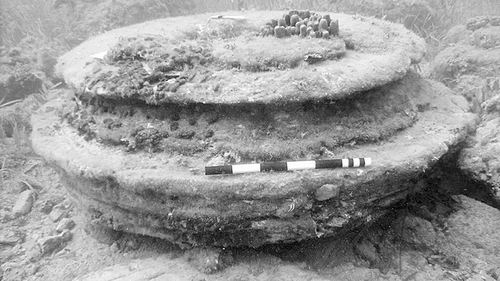(单词翻译:单击)
听力文本
This is Scientific American — 60-Second Science. I'm Cynthia Graber.
Got a minute?
Tourists snorkeling off the Greek island of Zakynthos in 2013 thought they had made a fabulous discovery: the remains of a lost city. They saw what appeared to be paving stones and the bases of columns in the blue water. But when the Greek government sent in researchers, they didn't find any other remnants of human activity, such as pottery. So scientists at the University of Athens and the University of East Anglia in England teamed up to investigate.
Julian Andrews, professor of environmental sciences at East Anglia, at first questioned his Athens colleague, geologist Michael Stamatakis.
"When I first saw the pictures I said to Michael, 'are you sure they're not real?' Because they really do look like columns. And he said, 'No no, definitely there's definitely something going on here more than more than that.'"
After analyzing the mineral content of the formations, Andrews agreed.
"So what we have here is essentially the byproduct of bacterial reactions. So they happen to look rather like human artifacts: buildings, columns, pavements. But they're actually examples of what we call concretion, this mineral that precipitates in the sediment."
They published their findings in the journal Marine and Petroleum Geology.

The bacteria responsible for the formations thrive near seeps — usually found in much deeper water than in this case — that vent gases such as methane. The microbes break down the methane as fuel. That act sets off a chain of reactions that leads to the creation of dolomite — basically a natural cement. The bacteria got to work on these formations long before Ancient Greece existed — or modern humans, for that matter.
"It looks like they could be as old as three or four million years old. So these would have been buried in the sediment millions of years ago and then have been eroded or exhumed by currents in modern coastal waters."
Underwater archaeology fans shouldn't be put off just because these ruins were built by bacteria.
"I think they're very beautiful things to see anyway, so it's still a great place to go snorkeling. And also when you build structures like this, where you have sort of columns and cavities and crypts and so forth, these are very good places. They're rather like reefs really…so I think people can enjoy the natural formations. It's just amazing how you have, how similar they do look to human remains and artifacts."
Thanks for a minute for Scientific American — 60-Second Science. I'm Cynthia Graber.
参考译文
这里是科学美国人——60秒科学。我是辛西娅·格雷伯。
有一分钟时间吗?
2013年,在希腊扎金索斯岛潜水的游客认为他们取得了惊人的发现:一座消失古城的遗迹。他们在蓝色海水里看到了像铺路石和廊柱石的残片。但是当希腊政府派研究人员去查证时,却并没有发现陶器之类的其他人类活动痕迹。因此,雅典大学和英国东英格利亚大学的科学家组成团队展开调查。
东英格利亚大学环境科学教授朱利安·安德鲁首先对他的雅典同事、地质学家迈克尔·斯塔马塔基斯提出了问题。
“我第一次看到这些照片时,我问迈克尔,‘你确定这些不是真的吗?'因为这些看上去的确很像真的石柱。他说,‘不是,不是真的,除了那些,肯定有其他奥秘。'”
在分析了构造物的矿物含量后,安德鲁对斯塔马塔基斯的看法表示同意。
“从本质上说,这些是细菌反应的副产物。它们恰巧看上去像大楼、石柱、铺路石等人类遗迹。但是它们其实是固结现象,就是矿物沉积形成的沉积物。”
科学家将这一发现发表在《海洋和石油地质学》杂志上。
细菌促成了这种在渗漏处形成的构造,通常这种构造在更深的水域发现,一般在能排放出甲烷等气体的深海。微生物将甲烷分解作为燃料。这一行为引发了一系列反应,制造出天然水泥——白云石。这种细菌制造的结构形成时间远在古希腊之前,可以说远早于现代人类史。
“看上去它们可能有三四百万年的历史。它们可能在几百万年前被埋于沉积物中,然后在现代海岸被水流侵蚀或冲刷出来。”
水下考古爱好者不要因为这些是被细菌创造出来的遗迹而感到失望。“我认为不管怎样,它们非常漂亮,这仍是一个潜水圣地。在创造出这些结构的地方,有这种石柱、洞穴和地窖的地方都是潜水好去处。它们有点像暗礁,我认为人们会喜欢这种自然形成物的。这些构造的形成过程以及它们和人类遗迹的相像程度足以让人惊奇不已。”
谢谢大家收听科学美国人——60秒科学。我是辛西娅·格雷伯。
译文为可可英语翻译,未经授权请勿转载!
重点讲解
重点讲解:
1. send in 派遣,调来(警察、军队等以应付危机或困难);
例句:It's time to send in the lawyers.
该是指派律师的时候了。
2. team up (与…)组队;(与…)协作;
例句:The third and fourth grade team up to decorate the gym for the party.
三、四年级的学生一起合作,为联谊会布置体育馆。
3. break down (使)(物质)分解;
例句:Sugar and starch are broken down in the stomach.
糖和淀粉在胃里被分解。
4. set off 引发;触发;激起;
例句:The miners' action might set off sympathy strikes by transport workers.
矿工的行动可能引起运输工人的同情性罢工。
5. for that matter 同样;而且;
例句:I didn't like it much. Nor did the kids, for that matter.
我不怎么喜欢它。孩子们也同样不喜欢。
6. put off 使反感;使对…失去兴趣;
例句:The high divorce figures don't seem to be putting people off marriage.
离婚的人很多,但这好像并没有打消人们对结婚的热情。
7. and so forth 及诸如此类;等等;
例句:The grocer deals in tea, coffee, spices and so forth.
该杂货店经销茶叶、咖啡、佐料等商品。


